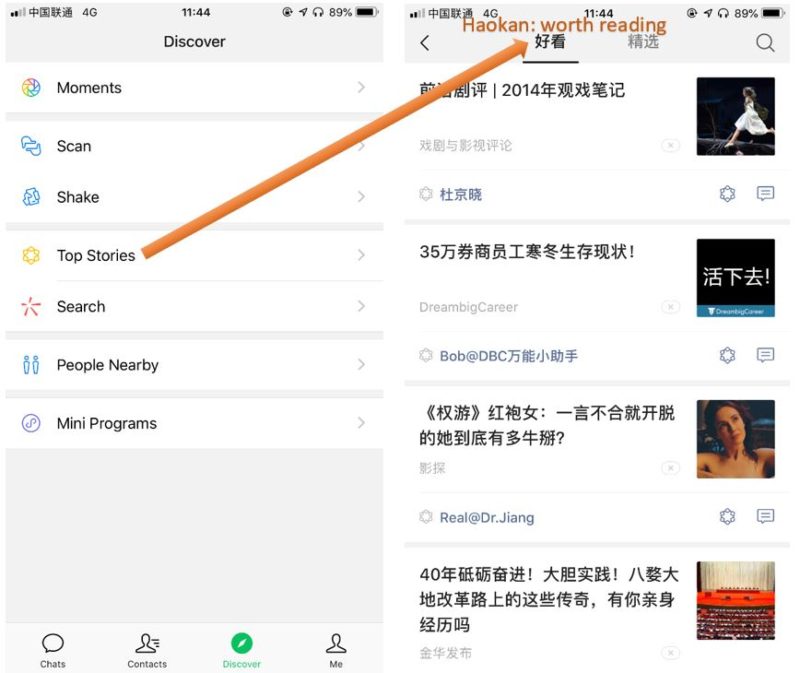What international brands should know about WeChat’s latest update | Daxue Consulting
On December 21, 2018, WeChat released an update, which brought a lot of changes and new features. For those who are not familiar with it, WeChat is the most popular multifunctional messaging, social media and mobile payment app in China with over 1 billion monthly active users. It is one of the most powerful tools to engage with Chinese consumers online. In this article, Daxue Consulting will look into the biggest update of WeChat since 2014 and analyze the effects it will have on international brands.
Besides many small modifications, there are two eye-catching new features:
1. From [Like] to [Haokan] (好看, worth reading)
![]()
This might be the most impactful change to brands and companies who share content on WeChat. Until now, WeChat users can only repost the content they like from WeChat Official Accounts to [Moments] or directly send it to friends. Clicking on [LIKE] won’t help the content spread to a wider range. With the [Haokan] button, the posts will automatically be shared on [Top Stories] (看一看 Kanyikan) within the WeChat app. There, WeChat users can see all the posts, of which their friends have clicked on the [Haokan] button.
How does this affect content promotion?
From Daxue Consulting’s observations, the promotional effect of sharing content on [Moments] has been on the decline. Many people believe this new feature is good for content creators on WeChat since articles get another channel to be exposed. For international brands who seek publicity among Chinese consumers through WeChat, this new feature might help them reach a broader audience. Yet no one can know for sure, how Chinese netizens are going to react. It is possible that they won’t click on the [Haokan] button, once they realize their friends on WeChat could see what they have read and liked. Until now, the [Like] feature has been private for WeChat users, they can “like” the content without letting anyone else know. After the update, some KOLs on WeChat claimed to lose a huge amount of views without any obvious reason. The new feature might have led to this; some readers tend not to click on the [Haokan] button since they don’t want their friends to see what they have read., this might especially be the case for content with dark humor or intimate topics.

Screenshots: by clicking on the [Top Stories] (看一看kanyikan), WeChat users can see all the content on which their friends have clicked on the [Haokan] button
2. The [Time Capsule] feature
The new [Time Capsule] feature is similar to the “Stories” function from Instagram and Snapchat. WeChat users can upload an existing video clip or shoot a video directly through this new feature and post it on [Time Capsule]. They can also add location, emojis and text into this video clip to make it more personalized and fun. The videos will only show on users’ individual pages or in a chat window for 24 hours. Compare to the videos users post on [Moments], Time Capsule video can be 15 sec. long (5 sec. longer) and your friends won’t see them unless they go to your personal site directly.
What does this mean for foreign companies?
With emerging video creating and sharing social platforms like Douyin (抖音, launched in Sept. 2016), short videos are becoming popular among young Chinese netizens. Consequently, WeChat had been losing appeal not only to content consumers but also content creators and advertisers. With the new short-video function, WeChat tries to attract the young generation and compete with other social platforms. The new [Time Capsule] feature might not affect foreign brands on WeChat directly, yet it utilized to create more intimacy between users and make WeChat more fun for young consumers, as a result, increase the use frequency of the App.
How are Chinese netizens reacting to the latest version of WeChat?

Screenshot: #WeChat huge update becomes a hot topic on Weibo
On Chinese biggest micro-blogging platform Weibo, #微信大改版 (#WeChat huge update) has become a hot topic, which has 640 million of views and 60K related discussions. Chinese netizens seem to have very different attitudes towards this update, some of them claiming with regretting updated their WeChat, while others are excited to try out the new functions. For those who don’t like the new version, many of them dislike the new UI and the new [Top Stories] feature, which they think steals privacy from the users. On the other hand, some Chinese netizens like the new interface and look forward to using the new functions like [strong reminder]. The purpose of strong reminder is to ensure you don’t miss messages that are important to you. After setting someone as ‘strong reminder’, the message sent by this friend will be displayed in full screen within 2 hours.
First collected feedback from Chinese users
Since the update has been launched for only two weeks on Apple and a couple of days on Android, the amount of data regarding usage and user experience is very limited. Nevertheless, Daxue Consulting decided to reach to a panel of 35 actual users – heavy consumers of digital content – through an online mini-survey. The answers are good indicators of the overall reception of this update.
- Almost 1/3 of the users reached haven’t noticed the new update yet. From those who do know, the majority already upgraded their WeChat (either has done by themselves or by their smartphones automatically).
- 5 participants have not upgraded yet. From these 5 participants, 3 decided not to upgrade on purpose, since they have read the comments online that the new version is less good than the previous one.
- About the change from [Like] button to [Haokan], Chinese WeChat users seem to have very different opinions: Over half of the participants said they would like to share good content to their WeChat friends and/or are interested to see what their friends have recommended.
- However, almost 1/3 of the participants told us that they definitely won’t use the [Haokan] button because of the privacy issue. The rest participants haven’t noticed the feature yet.
- Towards the new [Time Capsule] feature, Chinese WeChat users’ attitudes are milder. About 2/3 of the participants find this feature interesting and think they might use it in the future. Some participants don’t think it will be in great demand. The rest participants don’t quite understand this feature yet.
Daxue suggestions for international brands on WeChat
From Daxue Consulting’s observation, the new features of WeChat tend to increase the content conversion by creating a new channel of sharing. Not only will the liked articles be exposed on [Top Stories] in addition [Moments], but also, high-quality content will be shared from top stories again, creating a healthy circulation for articles WeChat users deem worth reading. Content creators see this update as an opportunity to gain publicity, since, in the last couple of years, WeChat has faced some difficulties within the content-ecology. Many content creators have realized a solidification of content transmission, this latest update is definitely a chance to energize the circulation of high-quality content on WeChat.
In our opinion, for WeChat Official Accounts with a high profile, this update might not be as effective as it is for small to middle sized accounts. As a matter of fact, in the last two weeks, several content creators with a middle-sized audience (10K views for an article in average) have already experienced a huge increase of the numbers of views. However, this might also be caused by the curiosity of the users trying out a new function, whether the positive effect will last, needs more time for observation. Good and interactive content is still the key to approach Chinese consumers on WeChat.
Author: Chencen Zhu
Daxue Consulting provides a tailor-made market survey in China
Daxue Consulting is able to run a high-quality market survey of any sector in the Chinese market. If you are thinking of entering the Chinese market or are already a market player but need fresh research do not hesitate to contact our project managers at dx@daxueconsulting.com.















